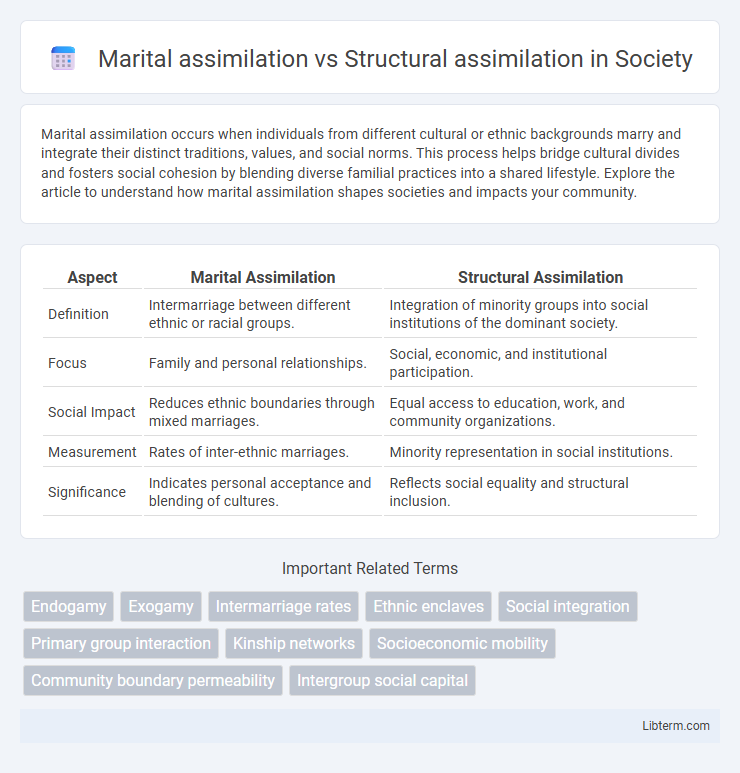Marital assimilation occurs when individuals from different cultural or ethnic backgrounds marry and integrate their distinct traditions, values, and social norms. This process helps bridge cultural divides and fosters social cohesion by blending diverse familial practices into a shared lifestyle. Explore the article to understand how marital assimilation shapes societies and impacts your community.
Table of Comparison
| Aspect | Marital Assimilation | Structural Assimilation |
|---|---|---|
| Definition | Intermarriage between different ethnic or racial groups. | Integration of minority groups into social institutions of the dominant society. |
| Focus | Family and personal relationships. | Social, economic, and institutional participation. |
| Social Impact | Reduces ethnic boundaries through mixed marriages. | Equal access to education, work, and community organizations. |
| Measurement | Rates of inter-ethnic marriages. | Minority representation in social institutions. |
| Significance | Indicates personal acceptance and blending of cultures. | Reflects social equality and structural inclusion. |
Understanding Marital Assimilation
Marital assimilation refers to the process by which individuals from different ethnic or cultural groups intermarry, leading to increased social integration and the blending of diverse communities. This form of assimilation reflects interpersonal relationships and intimate social bonds that help reduce ethnic boundaries. Understanding marital assimilation is crucial for analyzing how deeply minority groups integrate into the dominant society beyond economic or educational measures.
Defining Structural Assimilation
Structural assimilation refers to the process by which minority groups achieve integration into the social, economic, and institutional frameworks of the dominant society, evident through participation in organizations, workplaces, and educational institutions. Unlike marital assimilation, which emphasizes intergroup marriage patterns, structural assimilation highlights the breakdown of social barriers and equal access to social networks and institutions. Key indicators include representation in mainstream political, economic, and educational systems, reflecting true social inclusion beyond personal relationships.
Key Differences Between Marital and Structural Assimilation
Marital assimilation refers to the intermarriage between members of different ethnic or racial groups, serving as a direct indicator of social integration and acceptance at a personal level. Structural assimilation involves the entry of minority groups into the primary social institutions of the dominant society, such as education, employment, and residential neighborhoods, reflecting broader societal inclusion. Key differences include marital assimilation focusing on intimate social bonds while structural assimilation emphasizes institutional access and participation across various social spheres.
Historical Context of Assimilation Theories
Marital assimilation and structural assimilation represent key concepts in the historical context of assimilation theories, highlighting different dimensions of immigrant integration in society. Marital assimilation refers to intermarriage patterns between minorities and the dominant group, signaling social acceptance and blending of cultural boundaries, while structural assimilation involves the entry of minority groups into the core institutions of society such as education, employment, and residential neighborhoods, reflecting broader socio-economic integration. Historically, assimilation theories emerged during periods of increased immigration in the late 19th and early 20th centuries in the United States, addressing how immigrant groups adapted to the dominant Anglo-American culture amid shifting social and political landscapes.
Factors Influencing Marital Assimilation
Factors influencing marital assimilation include cultural proximity, socioeconomic status, and social networks, which shape intermarriage rates between immigrant and native groups. Educational attainment and language proficiency significantly enhance opportunities for cross-cultural marital unions by reducing social distance. Residential integration also plays a crucial role, as increased interaction in diverse neighborhoods facilitates the formation of interethnic relationships leading to marital assimilation.
Social Institutions and Structural Assimilation
Marital assimilation involves intermarriage between different cultural or ethnic groups, reflecting a personal and familial level of integration, whereas structural assimilation refers to the inclusion and equal participation of minority groups within key social institutions such as education, employment, and politics. Structural assimilation indicates a deeper societal integration where minority group members access similar social networks and resources as the dominant group, facilitating upward mobility and reducing social barriers. Social institutions play a crucial role in structural assimilation by shaping opportunities and norms that either promote or hinder the full incorporation of minority populations into the societal mainstream.
Intermarriage Rates and Their Implications
Intermarriage rates serve as a critical indicator differentiating marital assimilation from structural assimilation, with higher intermarriage rates reflecting greater marital assimilation by signifying intimate social integration across ethnic or racial lines. Structural assimilation, meanwhile, involves broader socio-economic and institutional integration, such as equitable access to education and employment, which does not necessarily guarantee high intermarriage rates. Understanding these distinctions aids policymakers in addressing social cohesion, as elevated intermarriage rates often correlate with diminished ethnic boundaries and increased cultural blending, whereas structural assimilation can proceed without significant changes in marital patterns.
Community Integration and Social Networks
Marital assimilation reflects deep community integration by fostering interpersonal ties and blending social networks across ethnic boundaries, which promotes social cohesion and reduces group segregation. Structural assimilation emphasizes participation in primary and secondary social institutions, such as workplaces and schools, expanding individuals' social networks beyond their native ethnic group. Both forms enhance social capital, but marital assimilation particularly transforms intimate social relations, while structural assimilation reshapes institutional engagement and public social interactions.
Challenges in Achieving Full Assimilation
Challenges in achieving full marital assimilation include cultural differences, religious beliefs, and societal acceptance, which often slow the integration between diverse ethnic groups through intermarriage. Structural assimilation faces obstacles such as segregation in housing, education, and employment, which limit minorities' access to mainstream social institutions and resources. Both types of assimilation encounter systemic discrimination and identity retention that hinder the seamless blending of minority populations into dominant social frameworks.
Future Trends in Assimilation Patterns
Future trends in assimilation patterns indicate a growing emphasis on marital assimilation as interethnic marriages become more common, fostering deeper cultural blending and social integration. Structural assimilation continues to evolve with increasing representation of minority groups in education, employment, and political institutions, which strengthens societal inclusion. Advances in multicultural policies and digital connectivity further accelerate these assimilation processes, promoting more fluid and dynamic integration experiences.
Marital assimilation Infographic

 libterm.com
libterm.com